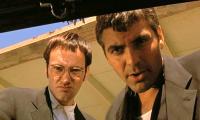Heatstroke has high mortality rate
Islamabad: As a severe heat wave has already hit several parts of the country and the summer season has almost set in all across Pakistan, the chances of incidences of serious heat-related threats like heat stroke are on the rise particularly in the regions having severe heat spells.
Many health experts believe that to avoid losses, there is a need to create awareness in time among public about serious heat-related threats like heat stroke that is considered as the most severe form of heat-related illnesses with mortality rate ranging from 10 per cent to 80 per cent.
Medically, the heat stroke is defined as a body temperature higher than 40.6 degree Celsius (105.1 degree Fahrenheit) due to environmental heat exposure. When heat gain exceeds heat loss, the body temperature rises. Classic heat stroke occurs in individuals who lack the capacity to modulate the environment such as infants, elderly individuals and individuals who are chronically ill and they need extra care and must avoid exposure to heat to avoid illness.
According to Consultant Intensive Care Medicine at Pakistan Institute of Medical Sciences Dr. Muhammad Haroon, heat stroke can be avoided by adopting simple preventive measures though in cases of delay in treatment, its mortality rate can be as high as 80 per cent however early diagnosis and cooling may reduce mortality rate to 10 per cent.
He said the heat stroke has two forms, one exertional heat stroke (EHS) generally occurs in young individuals who engage in strenuous physical activity for a prolonged period of time in a hot environment and the other classic non-exertional heat stroke (NEHS) that more commonly affects sedentary elderly individuals, persons who are chronically ill, and very young persons.
Classic NEHS occurs during environmental heat waves and is more common in areas that have not experienced a heat wave in many years. Both types of heat stroke are associated with a high morbidity and mortality, especially when therapy is delayed, he said.
Health experts say that it has been observed that most of the patients presented with heat stroke and life-threatening symptoms are labourers who work in outdoors in direct sunlight and are exposed to immense heat.
It is important that most of the public sector hospitals in Pakistan lack adequate treatment facilities for patients with heat stroke who need proper cooling facilities. If body temperature of a person goes up and the body stops sweating, it may be heat stroke and the person should immediately report to the nearest healthcare facility.
Experts say that people working in outdoors should take four to six litres of fluids every day that means 16 to 25 glasses of fluids; water, juices, lemon soda etc. They should also take bath at least once during mid-day to break the continuous cycle of heat in the body and give some rest to head dissipation systems of the body.
Dr. Haroon believes that drinking fluids on schedule and not based only on thirst, frequent cooling breaks, and frequent visits to cooler or air-conditioned places or frequent baths are very important because even short stays in a cool environment may drastically reduce the incidence of heat stroke.
-
 Prince William Takes Bold Move Amid Meghan Markle's Plans To Visit Britain
Prince William Takes Bold Move Amid Meghan Markle's Plans To Visit Britain -
 'Stranger Things' Star Recalls Emotional Last Day On Set
'Stranger Things' Star Recalls Emotional Last Day On Set -
 Briton Smith Stops Matias In Five To Win The WBC Title
Briton Smith Stops Matias In Five To Win The WBC Title -
 Kelly Clarkson Opens Up About Her Kids After Their Dad Passing
Kelly Clarkson Opens Up About Her Kids After Their Dad Passing -
 Google Removes AI Health Summaries After Safety Concerns
Google Removes AI Health Summaries After Safety Concerns -
 Meghan Markle, Prince Harry Warned About Ultimate High-stakes Gamble: 'It's A Bloodbath'
Meghan Markle, Prince Harry Warned About Ultimate High-stakes Gamble: 'It's A Bloodbath' -
 George Clooney Claps Back At Quentin Tarantino For 'cruel' Remarks
George Clooney Claps Back At Quentin Tarantino For 'cruel' Remarks -
 Scientists Discovered Never-before-seen Creature In Great Salt Lake
Scientists Discovered Never-before-seen Creature In Great Salt Lake -
 Three Viruses You Need To Watch Out For In 2026
Three Viruses You Need To Watch Out For In 2026 -
 Musk Says UK Targets Free Speech As X Faces Ban Over Grok AI
Musk Says UK Targets Free Speech As X Faces Ban Over Grok AI -
 'Hunger Games' Star Elle Fanning Reveals Her Goals For 2026
'Hunger Games' Star Elle Fanning Reveals Her Goals For 2026 -
 Zara Tindall Brings Exciting New Year Gift For Royal Family
Zara Tindall Brings Exciting New Year Gift For Royal Family -
 Prince Harry Offering King Charles To Take Part In Invictus Games 2027 Is 'not An Olive Branch'
Prince Harry Offering King Charles To Take Part In Invictus Games 2027 Is 'not An Olive Branch' -
 Inside Prince William's Secret 'war Plan' Against Harry
Inside Prince William's Secret 'war Plan' Against Harry -
 Kidney Damage Is Now Reversible: Here's Where Science Stands
Kidney Damage Is Now Reversible: Here's Where Science Stands -
 Google Maps Begins Rolling Out Redesigned Settings Page
Google Maps Begins Rolling Out Redesigned Settings Page



